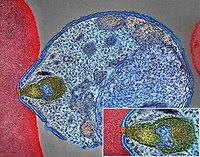
Photo from wikipedia
Background PfEMP1 is the major protein from parasitic origin involved in the pathophysiology of severe malaria, and PfEMP1 domain subtypes are associated with the infection outcome. In addition, PfEMP1 variability… Click to show full abstract
Background PfEMP1 is the major protein from parasitic origin involved in the pathophysiology of severe malaria, and PfEMP1 domain subtypes are associated with the infection outcome. In addition, PfEMP1 variability is endless and current publicly available protein repositories do not reflect the high diversity of the sequences of PfEMP1 proteins. The identification of PfEMP1 protein sequences expressed with samples remains challenging. The aim of our study is to identify the different PfEMP1 proteins variants expressed within patient samples, and therefore identify PfEMP1 proteins domains expressed by patients presenting uncomplicated malaria or severe malaria in malaria endemic setting in Cotonou, Benin. Methods We performed a multi-omic approach to decipher PfEMP1 expression at the patient’s level in different clinical settings. Using a combination of whole genome sequencing approach and RNA sequencing, we were able to identify new PfEMP1 sequences and created a new custom protein database. This database was used for protein identification in mass spectrometry analysis. Results The differential expression analysis of RNAsequencing data shows an increased expression of the var domains transcripts DBLα1.7, DBLα1.1, DBLα2 and DBLβ12 in samples from patients suffering from Cerebral Malaria compared to Uncomplicated Malaria. Our approach allowed us to attribute PfEMP1 sequences to each sample and identify new peptides associated to PfEMP1 proteins in mass spectrometry. Conclusion We highlighted the diversity of the PfEMP1 sequences from field sample compared to reference sequences repositories and confirmed the validity of our approach. These findings should contribute to further vaccine development strategies based on PfEMP1 proteins.
Journal Title: PLoS ONE
Year Published: 2019
Link to full text (if available)
Share on Social Media: Sign Up to like & get
recommendations!